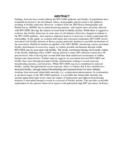| dc.contributor.author | Magadia, Monica Akinyi | |
| dc.contributor.author | Otieno, Alfred Agwanda | |
| dc.date.accessioned | 2013-07-01T06:55:53Z | |
| dc.date.available | 2013-07-01T06:55:53Z | |
| dc.date.issued | 2010-07 | |
| dc.identifier.citation | Social Science & Medicine | en |
| dc.identifier.uri | http://www.sciencedirect.com/science/article/pii/S0277953610003011 | |
| dc.identifier.uri | http://erepository.uonbi.ac.ke:8080/xmlui/handle/123456789/43088 | |
| dc.description.abstract | Findings from previous studies linking the HIV/AIDS epidemic and fertility of populations have remained inconclusive. In sub-Saharan Africa, demographic patterns point to the epidemic resulting in fertility reduction. However, evidence from the 2003 Kenya Demographic and Health Survey (KDHS) has revealed interesting patterns, with regions most adversely affected with HIV/AIDS showing the clearest reversal trend in fertility decline. While there is suggestive evidence that fertility behaviour in some parts of sub-Saharan Africa has changed in relation to the HIV/AIDS epidemic, more rigorous empirical analysis is necessary to better understand this relationship. In this paper, we examine individual and contextual community HIV/AIDS factors associated with fertility patterns in Kenya, paying particular attention to possible mechanisms of the association. Multilevel models are applied to the 2003 KDHS, introducing various proximate fertility determinants in successive stages, to explore possible mechanisms through which HIV/AIDS may be associated with fertility. The results corroborate findings from earlier studies of the fertility inhibiting effect of HIV among infected women. HIV-infected women have 40 percent lower odds of having had a recent birth than their uninfected counterparts of similar background characteristics. Further analysis suggests an association between HIV/AIDS and fertility that exists through proximate fertility determinants relating to sexual exposure, breastfeeding duration, and foetal loss. While HIV/AIDS may have contributed to reduced fertility, mainly through reduced sexual exposure, there is evidence that it has contributed to increased fertility, through reduced breastfeeding and increased desire for more children resulting from increased infant/child mortality (i.e. a replacement phenomenon). In communities at advanced stages of the HIV/AIDS epidemic, it is possible that infant/child mortality has reached appreciably high levels where the impact of replacement and reduced breastfeeding duration is substantial enough to result in a reversal of fertility decline. This provides a plausible explanation for the patterns observed in regions with particularly high HIV prevalence in Kenya. | en |
| dc.language.iso | en | en |
| dc.relation.ispartofseries | Volume 71, Issue 2, 2010, Pages 335–344; | |
| dc.subject | Kenya | en |
| dc.subject | HIV/AIDS infection | en |
| dc.subject | Fertility patterns | en |
| dc.subject | Proximate determinants | en |
| dc.subject | Reproductive preferences | en |
| dc.subject | Contextual community factors | en |
| dc.title | Investigating the association between HIV/AIDS and recent fertility patterns in Kenya | en |
| dc.type | Article | en |
| local.publisher | Department of Population Studies and Research Institute, University of Nairobi | en |
| local.publisher | Sociology, City University, London, United Kingdom | en |

